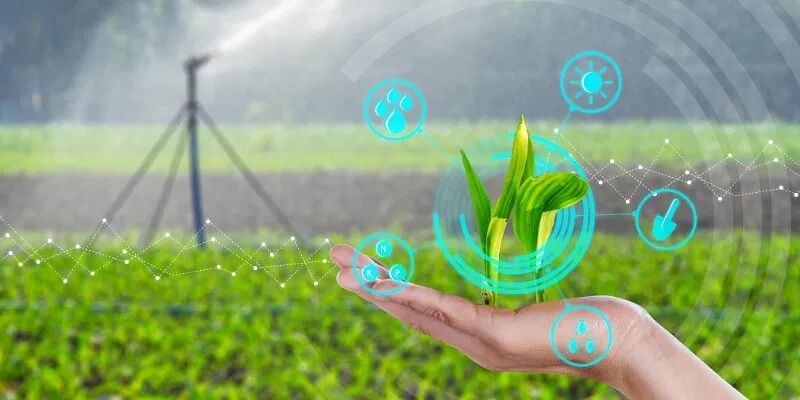Potential for augmentation
Pandemic-driven adoption of technological innovation in agriculture can be scaled countrywide with required funding and involvement of FPOs and local governments

The 2022-23 Union Budget has emphasised the involvement of public sector research and extension institutions along with private agritech players in delivery of digital and high-tech services to farmers. It also envisages use of 'kisan drones' for crop assessment and spray of pesticides and nutrients.
The 'Digital India Initiative' aims at widespread adoption of technology through digital platforms, analytics, artificial intelligence, blockchain, machine learning, Software as a Service (SaaS) and Internet of Things (IoT) in agriculture. The objective is to raise income of over 80 per cent small and marginal farmers who may not have the capacity or technological support to improve farm efficiency.
In the above context, the reformed Rastriya Krishi Vikas Yojana (RKVY) has now been innovatively designed to promote agritech. Herein, five national knowledge partners and 24 agri-business incubators across the country are supporting agri-preneurship and startups, in addition to institutions such as International Crops Research Institute for Semi-Arid Tropics (ICRISAT) and National Academy of Agricultural Management (NAARM). The areas of 'idea' incubation are as diverse as farm inputs, precision agriculture, farm management, quality as well as traceability parameters, supply chain/output market linkages and access to financial services etc.
Besides, NITI Aayog's Atal Innovation Mission (AIM) is also a plug-in to aggressively push technological innovation with its over 1,000 Atal Tinkering Labs (ATLs) that have been set up across districts. State governments too have begun to implement localised agritech solutions in partnership with the private sector. Uttar Pradesh's incubation network at Indian Institute of Technology (IIT) Kanpur, in collaboration with Bill Melinda Gates Foundation and Tata Trusts, is an example in this regard.
Experts have opined that the onset of Covid-19 pandemic has led to aggressive adoption of automation, machines and technology. But the key issue, according to them, is still the small farm size, coupled with low digital adoption by small and marginal farmers. Hence, they recommend a hub and spoke model. Herein, more than 700 Krishi Vigyan Kendras (KVKs) or entities such as ITC's e-Choupal 4.0 can be hubs in agro-climatic regions to impart digital literacy as well as to share best practices with aggregated farmers in farms around these hubs.
Five steps taken by the Government of India in conjunction with state governments address the above concerns. One, making farm mechanisation equipment available to farmers through aggregated custom hiring, high-tech centers and machinery banks. Second, initiating the electronic National Agriculture Market (e-NAM) in 1,000 regulated wholesale spot markets for real time price discovery with quality assaying. Third, launching the scheme for creation of 10,000 Farmer Producer Organisations (FPOs) to bring economies of scale through aggregation, and allowing existing FPOs to trade online. Fourth, initiation of the creation of a federated national database for farm services. And last but not the least, launch of standard operating procedures for drone technologies, including financial assistance to farmer collectives for their use.
Experts also opine that agritech, without doubt, is relooking at the way food has been grown and distributed in the country. But technological innovations are also being triggered by critical factors such as climate change, reduction in water availability, tolerance of pests, decrease in quality of soils and labour shortages. Funding, therefore, specifically for on-farm management and precision agriculture, they suggest, has to be increased. The creation of 1-lakh crore Agri Infrastructure Fund (AIF) is a step in the right direction. It provides access to credit, with interest subvention, for agri-entrepreneurs, FPOs and governments to invest in rural community assets and post-harvest infrastructure.
Amongst over 600 agritech ventures, Fasal is an agri startup that has helped farmer Sangarmesh Talikotti to install sensors and cameras in his 2.5-acre tomato farm. The startup's Bengaluru-based artificial intelligence-driven platform regularly relays information to Talikotti's smartphone on the quantum of irrigation needs, risk of pest attack and use of pesticides. Data collected through readings is converted through 'Internet of Things' (IoT) into precise actionable intelligence.
On the other hand, AgNext is a Chandigarh-based startup that uses computer-based vision for effective post-harvest quality inspection of crops to substitute visual inspection. Startups such as Ninjacart, Crofarm and KrishiHub are procuring fruits/vegetables directly from farmers and selling those to retailers. They use myriad technologies to keep their target farmers abreast of quantum of demand and current prices, coupled with optimised logistics and online payments.
Another key issue raised by experts is that while such agri-startup initiatives do empower farmers, how can they be scaled across the countryside? These entities have partially reformed the fragmented agri-value chain full of middlemen, and also continue to co-opt the unorganised retail industry consisting of small shops and street markets. One way to achieve scaling is by strengthening their partnership with FPOs and, more importantly, food-processing companies. This could be further coupled with extensive cross-country collaborations to support incubators, accelerators and investors supporting agritech.
An Ernst & Young 2020 study pitches India's agritech market at USD 24 billion by 2025 with the potential for supply chain technology and output markets at the highest. But this ecosystem can sustain at the last mile only when technology interventions are popular and adopted by small and marginal farmers. For this to happen, the state and district administrative machinery and, more importantly, local self-governance institutions have to be sensitised about agri-value chain technology issues. They, in turn, have to perform the role of effective trainers and leaders in dissemination of the same to small and marginal farmers in the country.
The writer is an Additional Secretary in the Ministry of Agriculture & Farmers Welfare, Government of India. Views expressed are personal



